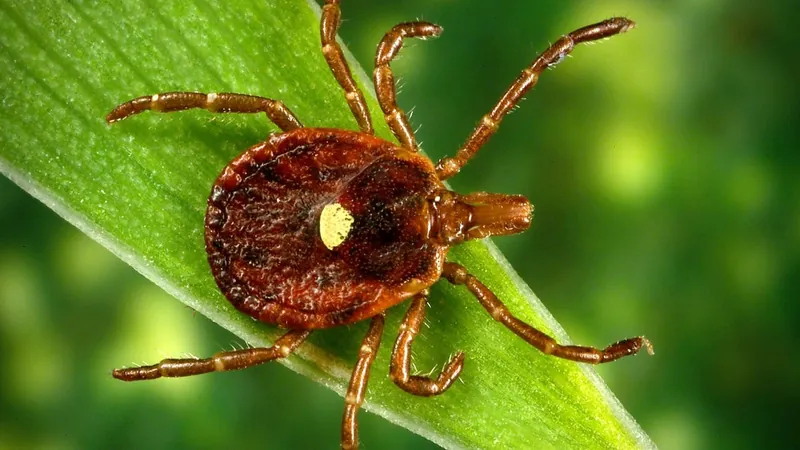
Beware the Ticks: Indiana Faces Record Infestation – Here’s What You Need to Know
2025-05-21
Author: Wai
Outdoor adventurers in Indiana are facing a tick crisis! Reports indicate a surge in tick populations, alarming both residents and health officials. The good news? Significant tick-borne diseases have yet to be reported; the bad news? If people don’t take proactive measures, that could soon change.
Lee Green, a senior medical entomologist at the Indiana Department of Health (IDOH), warns, "We've received countless calls and are collecting ticks in large numbers this season." The current tick activity is primarily in the nymph stage, meaning they are minuscule and easily overlooked, yet pose a higher risk of transmitting diseases.
Indiana’s Newest Tick Threats
Among the newcomers, the Gulf Coast tick has been detected across 14 counties in Indiana, having been first noted in 2017-18. Although they resemble the American dog tick, Gulf Coast ticks are on the rise, signaling potential new health risks.
Then there's the Asian longhorned tick—the first species to invade the U.S. in nearly 80 years! Currently located in only a few counties, while they rarely bite humans, they can transmit harmful parasites to livestock.
The Reality of Tick-Borne Illnesses in Indiana
Every year, Indiana sees between 300 and 400 tick-related illnesses. Lyme disease is the most common, particularly in the northwest. Symptoms often begin with a telltale "target" rash, while the southern parts of the state are plagued by Rocky Mountain spotted fever and ehrlichiosis.
But it's not just the familiar diseases that pose a threat. The Bourbon virus and Powassan virus are two emerging risks. Symptoms include fever and fatigue, but unlike bacterial infections, these viral illnesses require time to run their course without antibiotic treatment.
A New Allergy Linked to Ticks
Adding to the growing concerns, the phenomenon known as alpha-gal syndrome—an allergy to red meat—has been linked to lone star tick bites. This condition can lead to severe allergic reactions after consuming red meat. What’s worse? Many may have this allergy without even knowing it!
Tick Species Found in Indiana
Indiana is home to six tick species capable of spreading diseases. Here's what you should know:
• **American dog tick**: Transmits Rocky Mountain spotted fever and tularemia.
• **Black-legged tick**: Responsible for Lyme disease, anaplasmosis, and Powassan virus.
• **Brown dog tick**: Another carrier of Rocky Mountain spotted fever.
• **Gulf Coast tick**: Responsible for Rickettsioses.
• **Lone star tick**: Spreads multiple diseases including ehrlichiosis and alpha-gal syndrome.
• **Asian longhorned tick**: Currently not linked to human illness but a problem for livestock.
How to Protect Yourself and Your Family
To ward off ticks, experts recommend wearing long-sleeved clothing treated with permethrin. Spraying exposed skin with repellents containing DEET is also vital. After outdoor activities, conducting thorough tick checks is essential—you never know where these stealthy pests might hide!
Maintaining a Tick-Free Yard
Prevention isn’t just about personal care. Ticks thrive in humid environments, so keeping grass mowed and sunny play areas can significantly reduce their presence. Create gravel barriers in gardens to thwart tick migration and keep those pesky bugs at bay!
What to Do if You’re Bitten
If you discover a tick attached to your skin, remove it promptly using tweezers. Monitor for symptoms over the next few weeks. If a rash or fever develops, immediate medical consultation is crucial. Early intervention can prevent complications for most tick-borne diseases.
Stay vigilant, Hoosiers! While tick populations are booming, protecting yourself and your family can mitigate the risks significantly.



 Brasil (PT)
Brasil (PT)
 Canada (EN)
Canada (EN)
 Chile (ES)
Chile (ES)
 Česko (CS)
Česko (CS)
 대한민국 (KO)
대한민국 (KO)
 España (ES)
España (ES)
 France (FR)
France (FR)
 Hong Kong (EN)
Hong Kong (EN)
 Italia (IT)
Italia (IT)
 日本 (JA)
日本 (JA)
 Magyarország (HU)
Magyarország (HU)
 Norge (NO)
Norge (NO)
 Polska (PL)
Polska (PL)
 Schweiz (DE)
Schweiz (DE)
 Singapore (EN)
Singapore (EN)
 Sverige (SV)
Sverige (SV)
 Suomi (FI)
Suomi (FI)
 Türkiye (TR)
Türkiye (TR)
 الإمارات العربية المتحدة (AR)
الإمارات العربية المتحدة (AR)